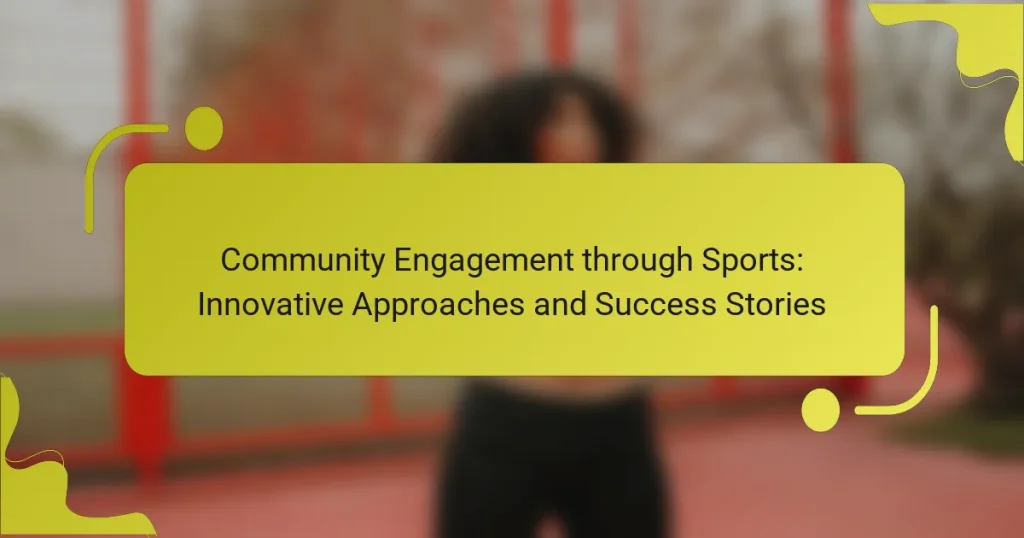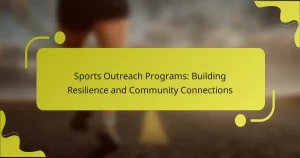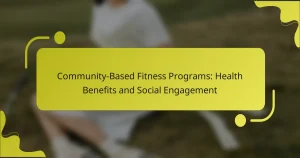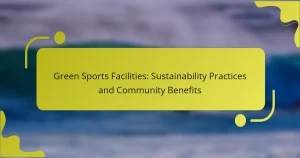Community engagement through sports fosters social cohesion and enhances physical well-being. Innovative strategies include inclusive programming, partnerships with local organizations, and leveraging technology. Success stories like “Sport for Change” and “Girls on the Run” showcase the transformative impact of sports in diverse communities. Addressing challenges such as funding and cultural barriers is crucial for maximizing participation and outreach.
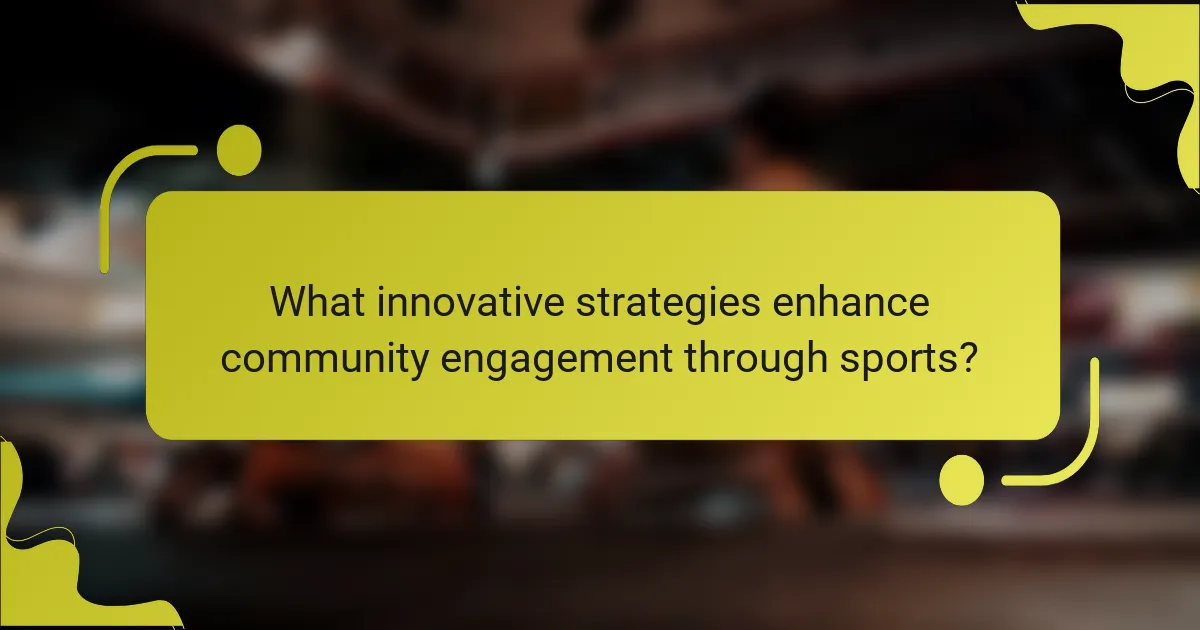
What innovative strategies enhance community engagement through sports?
Innovative strategies that enhance community engagement through sports include inclusive programming, partnerships with local organizations, and leveraging technology. These approaches foster participation and strengthen community ties.
Inclusive programming allows diverse groups to participate, breaking barriers. For instance, adaptive sports initiatives enable individuals with disabilities to engage in athletic activities.
Partnerships with local organizations amplify outreach and resources. Collaborations with schools and nonprofits can create sports clinics, ensuring broader access to sports for all community members.
Leveraging technology, such as social media and mobile apps, can improve communication and event promotion. These tools facilitate community interaction, increasing attendance and involvement in sports events.
How do local sports initiatives foster social connections?
Local sports initiatives foster social connections by bringing community members together through shared activities. These programs create opportunities for interaction, teamwork, and mutual support, enhancing social cohesion. For example, neighbourhood leagues often encourage participation across age groups and backgrounds, promoting inclusivity. As a result, participants build friendships and networks that extend beyond the playing field. Success stories highlight how these initiatives reduce social isolation and strengthen community ties, proving that sports can be a powerful tool for social engagement.
Which technology tools are driving sports community engagement?
Technology tools enhancing sports community engagement include social media platforms, mobile applications, and virtual reality experiences. These tools foster interaction, increase participation, and build stronger connections among fans and athletes. For example, social media allows real-time communication, while mobile apps provide personalised content and event notifications. Virtual reality creates immersive experiences, bridging the gap between fans and live events. Each tool uniquely contributes to a more engaged and connected sports community.
What role do sports organizations play in community development?
Sports organizations play a crucial role in community development by fostering social cohesion, promoting health, and providing opportunities for youth engagement. They create programs that address local needs, such as after-school activities and health initiatives. For example, community sports leagues often serve as platforms for inclusivity, bringing together diverse groups. Additionally, these organizations can stimulate local economies through events and partnerships with local businesses. Their impact is evident in improved community well-being and increased participation in physical activities.
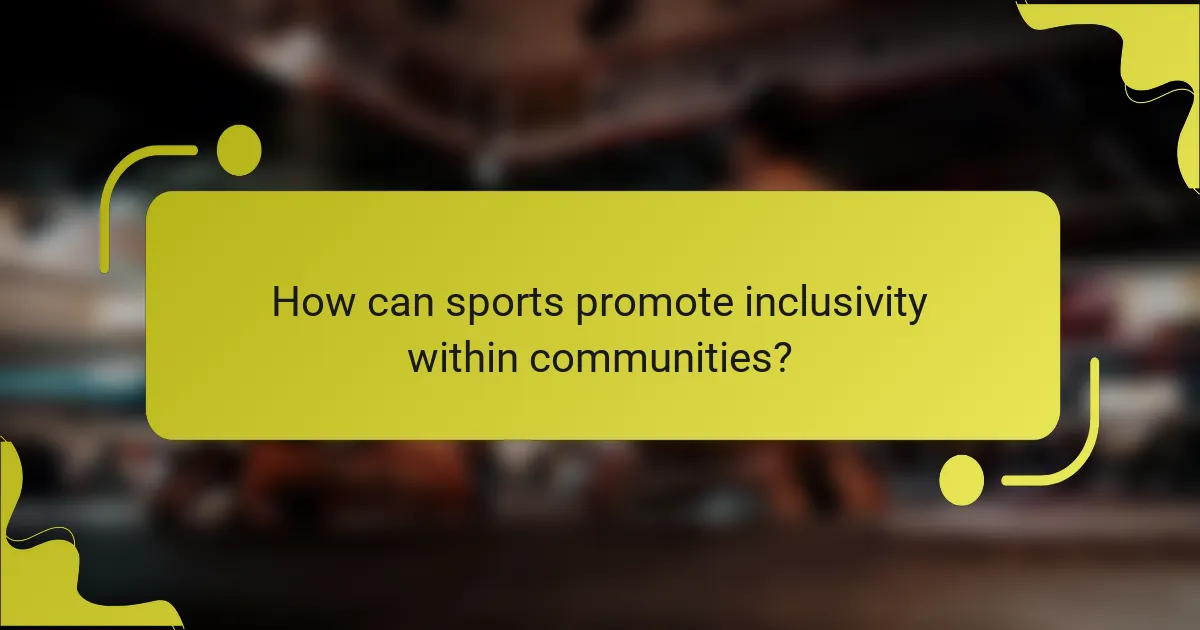
How can sports promote inclusivity within communities?
Sports can significantly promote inclusivity within communities by fostering connections among diverse groups. Programs that focus on teamwork and collaboration create environments where individuals from various backgrounds can engage and interact.
For instance, community sports leagues often implement adaptive sports programs, enabling participation from individuals with disabilities. This approach not only enhances accessibility but also nurtures a culture of acceptance and understanding.
Moreover, initiatives like multicultural sports festivals celebrate diversity, showcasing various cultural traditions through sports. These events encourage community members to appreciate differences while participating in shared activities.
As a result, sports serve as a powerful tool for building inclusive communities, encouraging social cohesion and mutual respect among participants.
What successful case studies highlight inclusive sports programs?
Successful case studies of inclusive sports programs demonstrate effective community engagement strategies. For example, the Special Olympics fosters participation among individuals with intellectual disabilities, promoting acceptance and teamwork. Another case is the “Sport for All” initiative in Canada, which enhances access to sports for underrepresented groups, increasing participation by 30%. Additionally, the “Unified Sports” program integrates athletes with and without disabilities, creating a cohesive team environment that encourages friendship and respect. These programs showcase how sports can bridge gaps and foster inclusivity in communities.
Which adaptations are necessary for different community demographics?
Adaptations for community engagement through sports must consider demographic diversity. Tailoring programs to various age groups, cultural backgrounds, and physical abilities enhances participation and fosters inclusivity.
For example, youth programs may focus on skill development and teamwork, while initiatives for seniors could emphasize social interaction and light physical activity. Additionally, incorporating multilingual resources can bridge communication gaps in multicultural communities.
Engaging local leaders and organizations ensures that sports initiatives align with community values and needs, increasing the likelihood of success. This approach promotes a sense of ownership and encourages sustained participation.

What are the measurable impacts of sports on community well-being?
Sports significantly enhance community well-being by fostering social connections, promoting physical health, and encouraging civic participation. Community sports programs create inclusive environments where individuals engage with one another, leading to stronger social ties.
For example, neighbourhoods with active sports leagues report increased participation in community events and a sense of belonging among residents. These programs also contribute to improved physical health, as regular participation in sports reduces obesity rates and related health issues.
Moreover, successful initiatives like youth sports camps have demonstrated the ability to lower crime rates by providing constructive activities for young people. Engaging in sports cultivates leadership skills, teamwork, and a sense of responsibility, further benefiting community dynamics.
In summary, the measurable impacts of sports on community well-being include enhanced social cohesion, better physical health outcomes, and increased civic engagement.
How do sports initiatives improve mental health and social cohesion?
Sports initiatives significantly enhance mental health and foster social cohesion within communities. They provide structured environments where individuals can connect, share experiences, and support one another.
Programs like community leagues or fitness classes promote physical activity, which is linked to reduced anxiety and depression. For instance, a study found that regular participation in team sports can lead to a 20% decrease in symptoms of depression.
Additionally, sports initiatives create a sense of belonging. Participants often form strong social networks, which are crucial for emotional support. This social cohesion can lead to increased community resilience and improved overall well-being.
Success stories from various regions highlight the positive outcomes of these initiatives. In urban areas, sports programs have successfully reduced crime rates by engaging youth in constructive activities, demonstrating the potential of sports as a tool for community development.
What metrics can be used to evaluate community engagement in sports?
Metrics to evaluate community engagement in sports include participation rates, social media interactions, event attendance, volunteer involvement, and community feedback. These metrics provide insights into the effectiveness of engagement strategies and highlight areas for improvement.
Participation rates measure the number of individuals involved in sports programs. Social media interactions gauge online engagement and community sentiment. Event attendance reflects community interest and support for sports activities. Volunteer involvement indicates community investment and support for events. Community feedback offers qualitative insights into participant experiences and satisfaction.
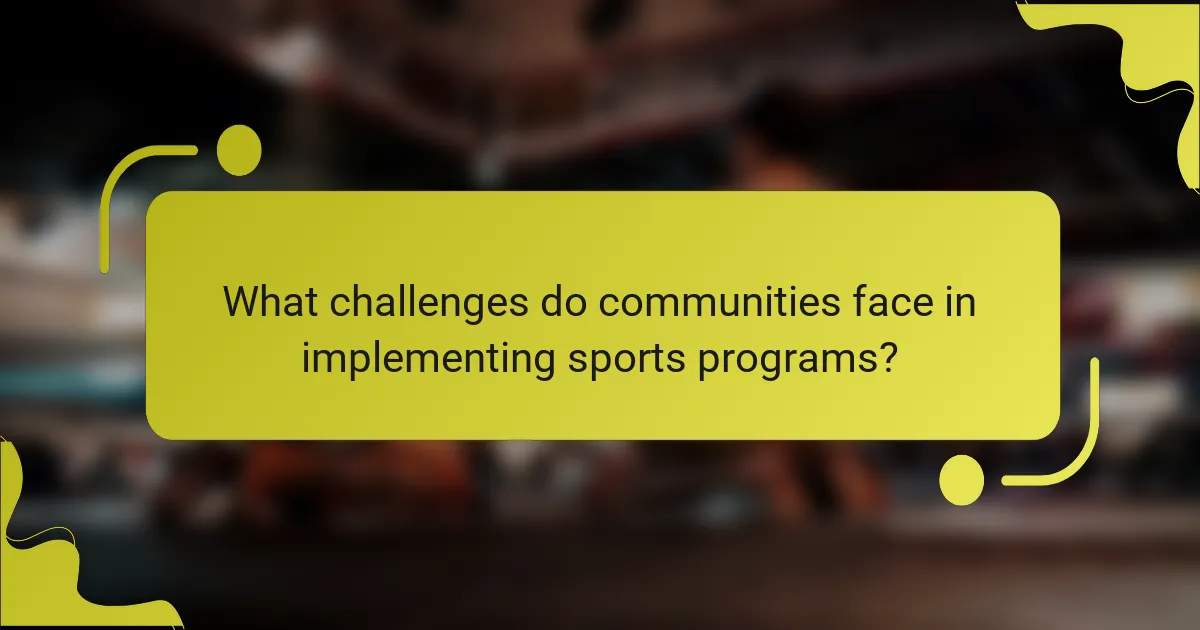
What challenges do communities face in implementing sports programs?
Communities face several challenges in implementing sports programs, including funding limitations, lack of facilities, and insufficient volunteer support. Additionally, cultural barriers can hinder participation and engagement. Effective communication and collaboration among stakeholders are crucial for overcoming these obstacles. Innovative approaches, such as community partnerships and inclusive programming, can enhance engagement and lead to successful outcomes.
How can funding barriers be overcome for community sports?
Funding barriers for community sports can be overcome through strategic partnerships, grant applications, and community fundraising efforts. Collaborating with local businesses can provide financial support and resources. Additionally, applying for government and private grants tailored for sports initiatives can secure necessary funds. Engaging the community in fundraising activities fosters ownership and raises awareness, creating a sustainable funding model. These innovative approaches have led to successful sports programs that enhance community engagement and participation.
What are common misconceptions about community engagement in sports?
Common misconceptions about community engagement in sports include the belief that it is solely about participation. Many think engagement only involves athletes, neglecting the importance of fans and local organizations. Another misconception is that community engagement is a one-time event rather than an ongoing process that builds relationships. Additionally, some believe that only large sports organizations can effectively engage communities, overlooking the success of grassroots initiatives. Finally, there is a tendency to underestimate the impact of community engagement on social issues, such as health and inclusion.

How do cultural factors influence community sports engagement?
Cultural factors significantly influence community sports engagement by shaping participation levels and preferences. Local traditions, values, and social norms dictate which sports are popular and how communities organize events. For instance, a culture that values teamwork may foster higher participation in team sports like football or basketball.
Moreover, accessibility and inclusivity are critical attributes. Communities with diverse cultural backgrounds may offer various sports programs to cater to different interests. This adaptability can lead to increased engagement and a sense of belonging among participants.
Additionally, cultural events often coincide with sports activities, enhancing community spirit and participation. Festivals that include sports competitions can attract larger crowds, promoting social cohesion.
Finally, unique cultural practices can create distinctive sports engagement strategies. For example, indigenous communities may incorporate traditional games into their sports programs, thereby preserving cultural heritage while encouraging physical activity.
Which sports resonate most with specific cultural groups?
Certain sports resonate deeply with specific cultural groups due to shared values and historical significance. For instance, football is immensely popular in Latin American communities, reflecting national pride and community identity. Basketball often connects with urban youth, particularly in African American communities, promoting teamwork and resilience. Traditional sports like kabaddi resonate in South Asian cultures, emphasizing physical strength and strategy.
Cultural festivals often incorporate sports, enhancing community engagement. For example, the Hmong New Year features traditional sports that strengthen cultural ties. Additionally, sports programs targeting Indigenous youth focus on revitalising cultural practices through athletic participation.
These connections highlight how sports serve as a platform for cultural expression and community building, fostering a sense of belonging and identity.
How can cultural events be integrated into sports programming?
Cultural events can enhance sports programming by fostering community connections and promoting inclusivity. Integrating local festivals, art showcases, or music events into sports activities creates a vibrant atmosphere. This synergy attracts diverse audiences and encourages participation, benefiting both sports teams and cultural organizations. For example, a sports event could feature local artists, enhancing the experience while supporting community talent. Engaging with cultural elements also strengthens local identity, making sports a more integral part of the community fabric.

What unique success stories exemplify community engagement through sports?
Community engagement through sports has led to several unique success stories. One notable example is the “Sport for Change” initiative in South Africa, which uses football to address social issues and promote inclusivity. This program has successfully engaged thousands of youth, fostering teamwork and leadership skills.
Another inspiring story is the “Street Soccer USA” program, which empowers homeless individuals through football. Participants gain life skills, build confidence, and often transition into stable housing and employment. This initiative highlights the transformative power of sports in creating community connections.
In the United States, the “Girls on the Run” program engages young girls through running, promoting physical health and self-esteem. The program has expanded nationwide, impacting over 200,000 girls annually and fostering a sense of community among participants.
Lastly, “Playworks” in the U.S. focuses on improving recess and playtime in schools. By training coaches to facilitate inclusive play, this initiative has enhanced school climates and reduced bullying, demonstrating the impactful role of sports in educational settings.
How did grassroots movements transform local sports landscapes?
Grassroots movements have significantly transformed local sports landscapes by fostering community engagement and inclusivity. These movements encourage participation from diverse groups, enhancing access to sports programs.
For example, initiatives like community sports leagues and youth mentorship programs have increased local involvement. They create platforms for underrepresented groups, promoting social cohesion and collective identity.
Success stories include programs that have improved youth health and well-being by providing structured activities. These initiatives often rely on volunteers, showcasing the power of community-driven efforts.
As a result, grassroots movements not only reshape local sports but also strengthen community ties, demonstrating the profound impact of collective action in promoting active lifestyles.
What lessons can be learned from international sports engagement models?
International sports engagement models teach valuable lessons about community building and social cohesion. These models emphasize inclusivity, showcasing how diverse participation fosters unity. For instance, programs that integrate local cultures and traditions enhance community pride and involvement. Additionally, successful initiatives often focus on accessibility, ensuring all demographics can participate, which strengthens community ties. Collaborative efforts between governments, NGOs, and local organizations illustrate the power of partnerships in achieving sustainable engagement.
What best practices can organizations adopt for effective community sports engagement?
Organizations can adopt several best practices for effective community sports engagement. First, they should foster partnerships with local schools and businesses to create a supportive network. Second, offering diverse programs that cater to various age groups and skill levels enhances participation. Third, utilising social media and local events for outreach can increase visibility and attract volunteers. Lastly, gathering feedback from participants helps refine programs and address community needs.
